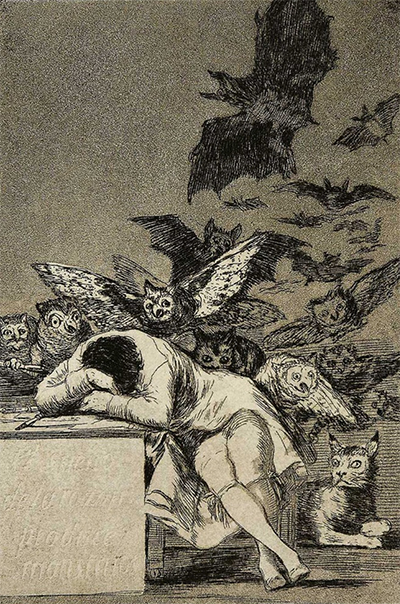Toward the end of his life, Francisco de Goya grew dissatisfied with his life. A darkness came over him that bled into his work, and his suffering - both external and internal - was translated into the content of his creations.
Los Caprichos is the result of this later time in Goya's life. As a set of eighty prints covering a number of different topics, they are well-known by people who appreciate Goya's detailed and varied works.
The prints themselves were in aquatint and etchings, all different but all with a similar dark feel to them. The most famous of these is referred to as 'The sleep of reason produces monsters', but due to its popularity it is sometimes referred to as 'Los Caprichos' rather than the full set of prints.
In the image, we see a man in a frock and breeches curled over a table or a desk with his head in his folded arms. He is a picture of despair, even though his dark hair completely hides his expression.
It can be surmised from the title of the piece that the man is intended to be asleep, though it does not look like a comfortable or satisfying rest. His position is awkward and seems tense. That is no surprise since behind the man are many beasts and birds crowding around him, all wide-eyed and dangerous-looking. The ones nearest the man are well-lit, but they descend quickly into shadows and create a menacing backdrop for the character.
The man in the etching is likely Goya himself, hiding from the demons of his own mind. When his reason sleeps, irrationality takes over; the animal self, or the darker aspect of the soul.
This was a part of his life that came with a lot of darkness and confusion so it is no wonder that Goya struggled with these menacing ideas. It is the sign of a great artist to be able to take such a complex, uncomfortable subject and turn it into an etching that has lasted two centuries in the public eye. Perhaps Goya found the process of putting his troubles onto canvas to be relaxing and refreshing, as many artists have claimed when creating difficult ideas from their own lives.
There is another layer to the meaning if the viewer looks deeper. After all, without the 'sleep of reason' in Los Caprichos we would not be viewing the work of art at all.
Though lack of reason creates 'monsters', it also creates art. The very horror that kept Goya tense also gave him the motivation to create something beautiful, something poignant. Perhaps Goya understood this himself and it prompted him to continue creating artwork even as his life became difficult and full of pain.
Each of the prints in Los Caprichos carries its own meaning, and it is stunning that Goya created them all in a very short time period in his life. He created them between 1797 and 1799 and they often depicted Spanish society in an unflattering way. In that aspect, this print could also be said to represent Spain itself, with Goya sleeping with the chaos and ignorance of his society took over. This could be another meaning for the 'monster' that is a common theme in his work.
One of the reasons we understand anything at all about Los Caprichos is that Francisco de Goya added a small commentary to the print to explain the meaning behind it, or at least one of the meanings he intended to portray. In this one it is in the lower left-hand corner. This explicit explanation of the meaning is unusual for many artists, but Goya had a point or two to make and he intended that no one would miss it.
Goya did not have a happy life, especially toward the end. It is remarkable then that he continued to create such beauty in the face of adversity as with 'Los Capricos'.




